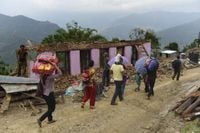Billions of pounds are being lost by global aid systems that wait until after disasters strike, rather than acting early to protect people and economies, according to a new analysis released on October 14, 2025. The study, conducted by the International Institute for Environment and Development (IIED), paints a stark picture: investing in resilience and anticipatory support before climate shocks hit can be up to five times more cost-effective than the traditional post-disaster aid approach.
For decades, the world’s response to climate disasters has been reactive. Governments and international donors typically step in with humanitarian relief or emergency social protection payments only after devastation has occurred. But as the IIED’s new research demonstrates, this model is not only inefficient—it’s costing far more than necessary, both in financial terms and in human suffering.
The IIED study, as reported by The Independent, modeled climate-related losses in eight countries across Africa and Asia—India, Pakistan, Bangladesh, Kenya, Ethiopia, Malawi, Mozambique, and Senegal. Using six decades of data on droughts, floods, and other shocks, researchers estimated that these countries face a staggering $21.4 billion (or £17.6 billion) in damages every 20 years. That’s roughly equivalent to the annual GDP of Senegal. The losses include everything from livestock deaths and destroyed infrastructure to mounting medical costs.
What’s truly eye-opening is the comparative cost of different approaches to managing these risks. If governments were to stick with current social protection systems—those that respond after the fact—it would take $93 billion (£76.4 billion) to fully offset the expected losses. Post-disaster humanitarian responses would cost $25.8 billion (£21.2 billion). In contrast, investing in resilience early—think reinforcing infrastructure, drought-proofing livelihoods, and strengthening disaster-response institutions—could achieve the same level of protection for just $4.1 billion (£3.4 billion).
“This evidence shows governments can protect people and economies at a fraction of the cost of waiting until disaster strikes,” said Ritu Bharadwaj, IIED’s director for climate resilience, finance, and loss and damage, and the study’s lead author. “The choice is simple. Invest early and save lives and money, or pay far more later when recovery is harder and families are already trapped in crisis.”
The report compared four types of interventions: existing social protection, humanitarian aid, anticipatory cash or food transfers before disasters, and long-term resilience investments. The results are striking. Every dollar spent on early resilience yields $5.17 (£4.25) in avoided losses and development gains. Anticipatory transfers—where support reaches communities in advance of forecasted events—return $2.06 (£1.70) per dollar spent. Humanitarian response, on the other hand, delivers less than one-to-one returns ($0.83 or £0.68), while existing social protection schemes provide just $0.23 (£0.19) per dollar invested, falling well below the break-even point.
What does this mean for the communities on the front lines of climate change? The average losses after climate shocks could be slashed dramatically: from 100 percent of baseline losses to just 27 percent with resilience investments, or 42 percent with anticipatory transfers, compared to 59 percent under humanitarian response. In other words, acting before disaster strikes isn’t just cheaper—it’s dramatically more effective at protecting lives and livelihoods.
The implications are particularly urgent for the eight countries at the heart of the IIED’s analysis. India alone could face over $11 billion (£9.03 billion) in 20-year losses. Pakistan’s risk stands at $6.5 billion (£5.34 billion), and Bangladesh’s at $2.3 billion (£1.89 billion). Many of these countries are already grappling with increasingly frequent droughts, floods, and storms as the planet warms, and the stakes are only getting higher.
The report’s findings echo a growing chorus of voices calling for a fundamental overhaul of the global aid system. Despite mounting evidence of the benefits of early action, most climate finance and development assistance still flows into emergency relief rather than proactive measures. “Countries are already using this analysis to prepare proposals for the new Fund for Responding to Loss and Damage,” Bharadwaj explained. “In an era of shrinking aid budgets, every dollar counts. If we spend those limited resources wisely on early action, we can save lives, protect economies, and avoid pouring money into inefficient systems that cost more than the disasters themselves.”
This conversation comes at a critical moment, with key international finance discussions looming ahead of Cop30 in Brazil. The design of the new Loss and Damage Fund is still under negotiation, and advocates say it could provide the financial architecture to support pre-arranged finance and early-warning systems—mechanisms that activate support before crises escalate out of control.
For the world’s poorest and most climate-vulnerable countries, the stakes could hardly be higher. Floods and heatwaves have disrupted farming patterns, intensified existing problems, and overwhelmed disaster response capacity across Africa, Asia, and Latin America. Over the past two decades, disasters have cost these regions more than a hundred billion pounds. Yet, as the IIED’s analysis shows, the poorest countries are also spending billions more to repay debts than they receive in funding to fight the climate crisis—a cruel irony that leaves them even less able to invest in resilience.
The IIED’s report is part of a broader push to rethink how the international community responds to climate risk. The evidence is clear: waiting for disaster to strike is not only a recipe for mounting costs but also a missed opportunity to protect the most vulnerable. As policymakers prepare for the next round of global negotiations, the hope is that these findings will spur a shift toward smarter, more cost-effective, and humane approaches to disaster risk management.
In the end, the choice seems obvious: invest early, and everyone stands to gain. Ignore the evidence, and the price—both human and economic—will only climb. As the world faces an era of increasingly severe climate shocks, the lesson from the IIED’s research is as timely as it is urgent: the best defense is a good offense, and when it comes to climate resilience, there’s no time to lose.




